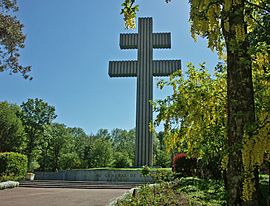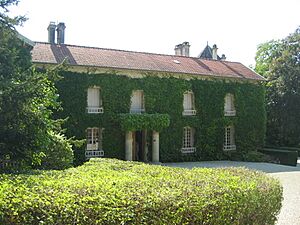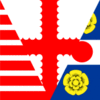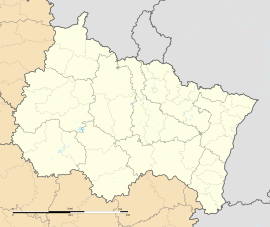Colombey-les-Deux-Églises facts for kids
Quick facts for kids
Colombey-les-Deux-Églises
|
|||
|---|---|---|---|

Charles de Gaulle Monument
|
|||
|
|||
| Country | France | ||
| Region | Grand Est | ||
| Department | Haute-Marne | ||
| Arrondissement | Chaumont | ||
| Canton | Châteauvillain | ||
| Intercommunality | CA Chaumont | ||
| Area
1
|
83.84 km2 (32.37 sq mi) | ||
| Population
(2021)
|
679 | ||
| • Density | 8.099/km2 (20.976/sq mi) | ||
| Time zone | UTC+01:00 (CET) | ||
| • Summer (DST) | UTC+02:00 (CEST) | ||
| INSEE/Postal code |
52140 /52330
|
||
| 1 French Land Register data, which excludes lakes, ponds, glaciers > 1 km2 (0.386 sq mi or 247 acres) and river estuaries. | |||
Colombey-les-Deux-Églises (French pronunciation: [kɔlɔ̃bɛ le dø.z‿eɡliz]) is a small village in north-eastern France. It is located in the Haute-Marne area. This village is most famous for being the home of Charles de Gaulle. He was a very important French leader in the 20th century.
The village of Colombey-les-Deux-Églises was officially created in 1793. Over the years, it has grown by joining with nearby smaller villages. For example, in 1973, it joined with Argentolles and six other communes. Later, in 2017, Lamothe-en-Blaisy also became part of Colombey.
The name "Colombey" comes from a Latin word meaning "cemetery." The "two churches" in its name refer to two important churches. One is the local parish church, Notre-Dame-en-son-Assomption. The other was a special church called a priory, Saint-Jean-Baptiste, from a long time ago.
Charles de Gaulle's Home

Colombey became very well-known because of Charles de Gaulle. He was a soldier and a leader who served as the President of France. In 1934, he bought a large property in the village. This home was called La Boisserie.
De Gaulle often came back to Colombey when he was not actively leading the country. He would stay there when he stepped away from politics. For example, he lived there between 1953 and 1958. He returned to lead France again during a big crisis in 1958. His final return to Colombey was in 1969. He passed away there the next year. Because of him, "Colombey" became a way to describe a leader taking a break from politics. It meant they might return if their country needed them again.
Charles de Gaulle is buried in the village cemetery in Colombey. His grave is simple, with just his name and the years he lived: "Charles de Gaulle 1890-1970."
To remember his important role during World War II, a tall monument was built. It is a 145-foot (44.3-meter) high Cross of Lorraine. This cross is a symbol of the Free French Forces that de Gaulle led.
A special museum, the Mémorial Charles-de-Gaulle, opened in October 2008. Important leaders like Nicolas Sarkozy of France and Angela Merkel of Germany opened it. This event celebrated 50 years since Charles de Gaulle and Konrad Adenauer met in Colombey. Their meeting in 1958 was an important step in bringing France and Germany closer after the war.
Village Geography
The Blaise River flows through the area where Colombey-les-Deux-Églises is located.
Historical Meetings
On September 14, 1958, Charles de Gaulle welcomed Konrad Adenauer to his home, La Boisserie. Adenauer was the leader of West Germany at the time. This private visit was a key moment in building friendship between France and Germany.
See also
 In Spanish: Colombey les Deux Églises para niños
In Spanish: Colombey les Deux Églises para niños






